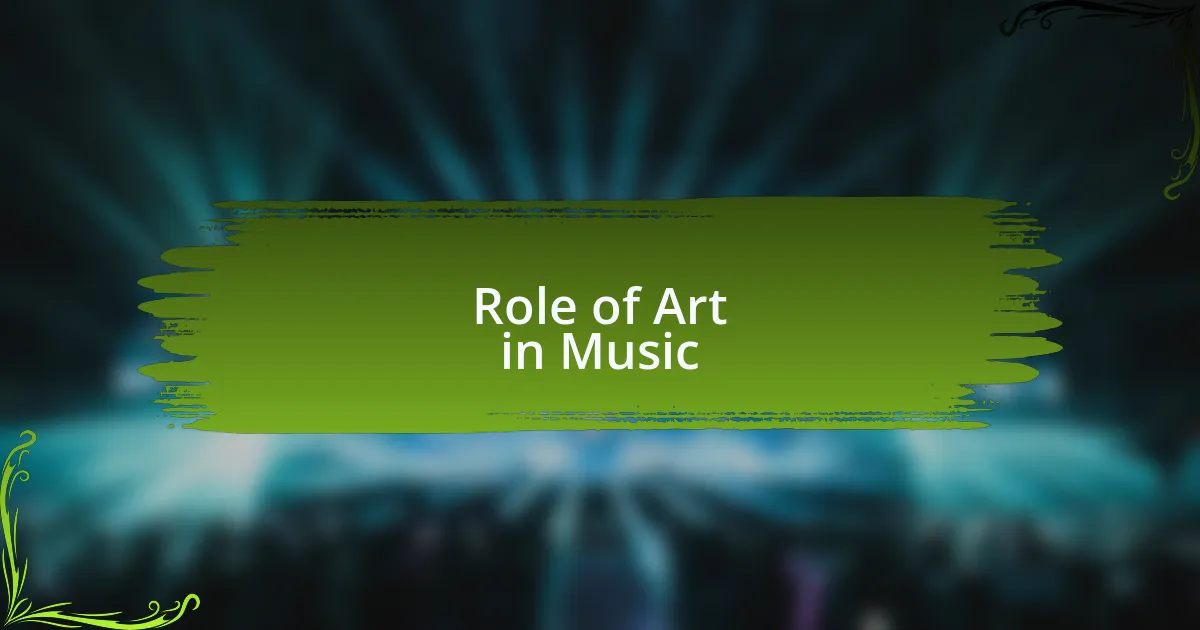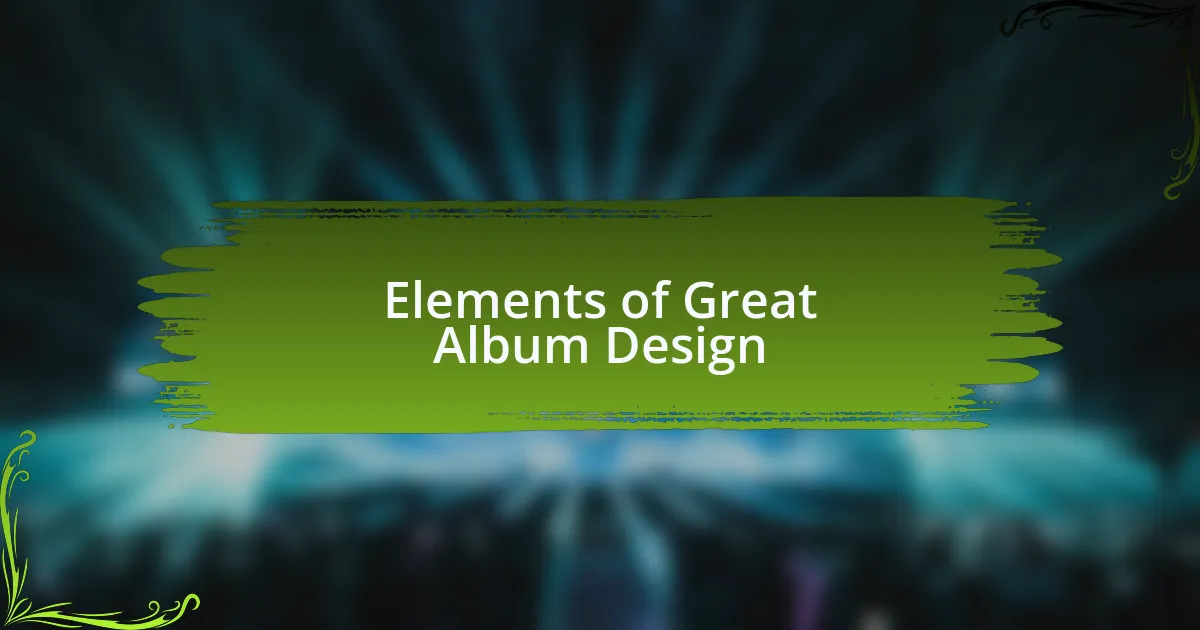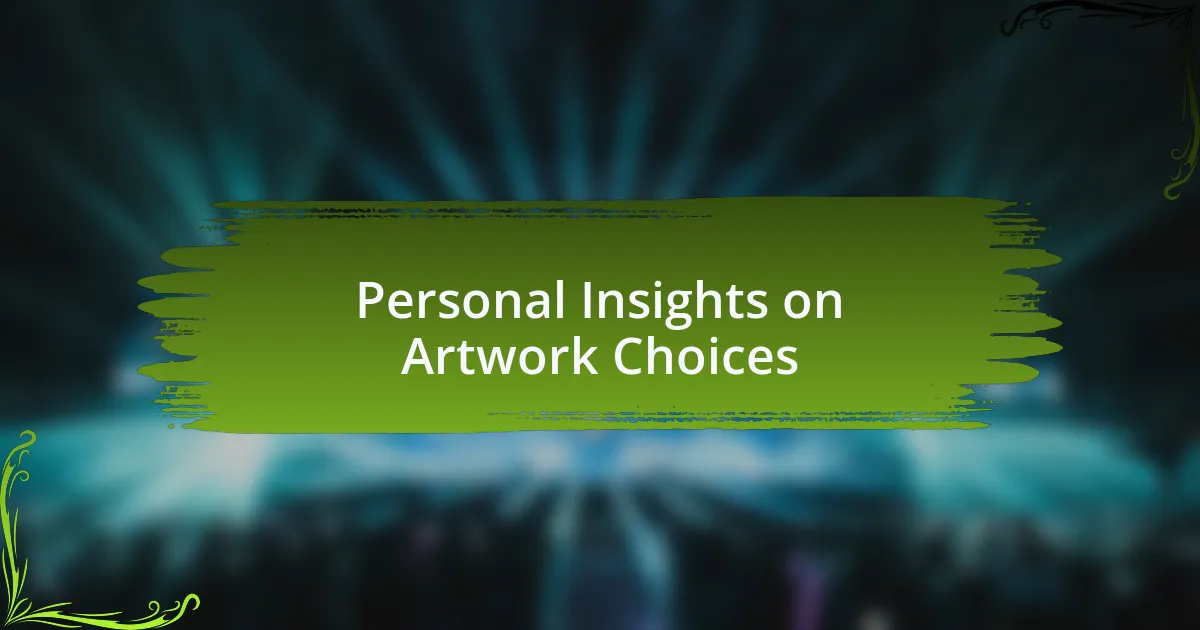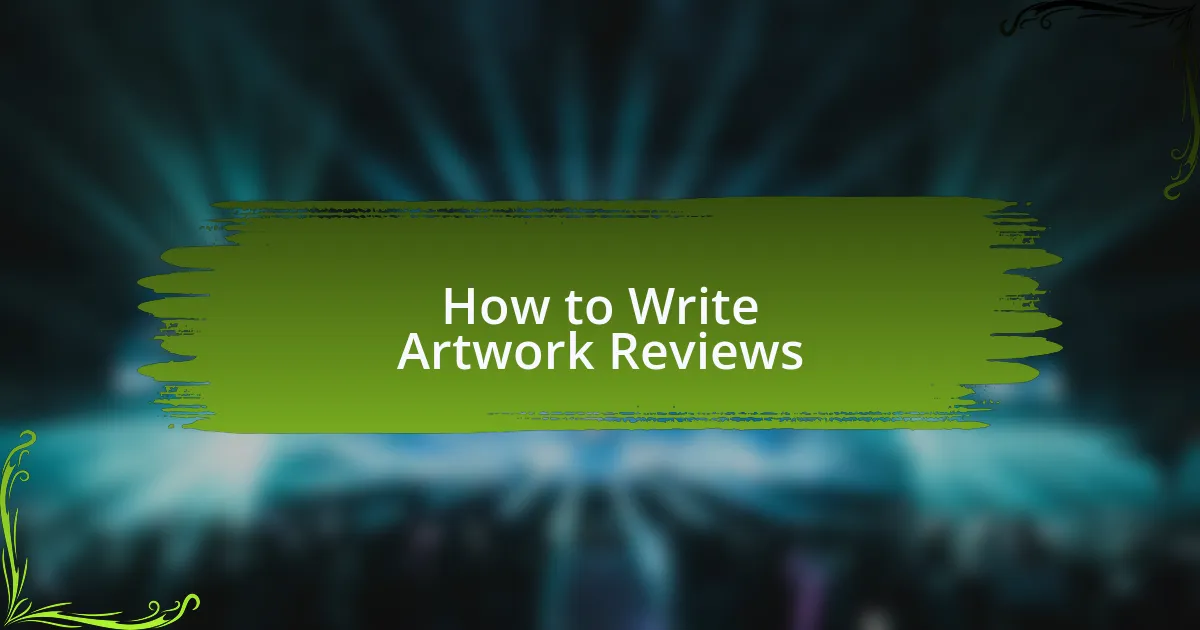Key takeaways:
- Album artwork serves as a visual gateway that shapes listeners’ expectations and emotions, often influencing their choice to listen to the music.
- Art in music acts as a bridge between the artist’s intent and listener interpretation, using imagery to evoke emotions and comment on cultural issues.
- Key elements of great album design include color, typography, and imagery, each contributing to the storytelling and emotional depth of the music experience.
- When writing artwork reviews, analyzing symbolism, genre relationships, and personal emotional responses can enhance the critique and connect with readers.

Understanding Album Artwork Importance
Album artwork serves as the visual gateway to the music contained within. I remember flipping through CD booklets as a kid, mesmerized by the vivid colors and intricate designs. Each piece told a story that paralleled the sound, sparking my imagination before I even hit play.
Consider this: does a striking album cover make you more likely to listen to the music? Personally, I’ve often chosen albums based on eye-catching artwork, feeling an instant connection before even hearing a note. The album cover isn’t just a protective sleeve; it’s an invitation, a first impression that can shape our expectations and emotions.
In many ways, album artwork encapsulates the artist’s vision and message. Take Pink Floyd’s “The Dark Side of the Moon,” for example. That prism encapsulates so much depth and complexity, resonating with themes of life and consciousness. Such imagery can linger in your mind, turning a simple record into a piece of art that evokes strong feelings long after the music stops playing. Can you remember the last time an album cover left you in awe or changed how you felt about the music?

Role of Art in Music
Art in music serves as a bridge between the artist’s intent and the listener’s interpretation. I recall discovering an indie band whose album cover, featuring a watercolor landscape, transported me to another world. It felt almost like stepping into a painting before experiencing the music, making me more curious about the journey that awaited me.
Each piece of album art has the potential to evoke emotions, similar to the melodies within the tracks. When I first encountered the haunting imagery of a spiraling staircase on an experimental album, it resonated deeply with my feelings of uncertainty. This visual representation set the tone for the music, resonating with the struggles and complexities of navigating life’s choices.
Moreover, album artwork acts as a canvas for cultural commentary. I think of albums that tackle social issues; their covers often reflect the message in a captivating way. For instance, consider the artwork of Kendrick Lamar’s albums—a striking image can amplify the themes of identity and resilience. Isn’t it fascinating how a single visual can provoke thought long before the first note plays?

Elements of Great Album Design
When it comes to great album design, the use of color is a fundamental element that can’t be overlooked. I remember flipping through vinyl records and stopping dead in my tracks at an explosive burst of color, which drew me in like a magnet. Color can convey mood and energy; a bright palette might suggest joy or excitement, while muted tones can evoke nostalgia or melancholy. How do you think an album might feel if wrapped in hues of gray versus a vibrant spectrum?
Typography also plays a critical role in album design. The font choice can tell a story before the music even begins. I’ve often found myself connecting to an album just because the typeface felt perfectly aligned with the artist’s identity—like the bold, distressed lettering on a punk rock record that screamed rebellion. This initial visual impression can create an immediate connection, raising my curiosity about the themes and emotions waiting inside. Have you ever picked up an album just because you loved the font?
Imagery is another vital aspect, often acting as a narrative piece in itself. One of my favorite album covers features a surreal collage that hinted at the eclectic sounds to come. I’ve learned that great album art often tells a story that complements the music. It makes me wonder—what journey is the artist inviting us to embark on? The right imagery can elevate the listening experience, ensuring that every time I revisit the album, it feels fresh and engaging.

Analyzing Artistic Techniques Used
When analyzing artistic techniques used in album artwork, I often consider the composition. For instance, a well-balanced arrangement can guide the viewer’s eye across the cover. I remember discovering an album where the central image was offset by geometric shapes, creating depth that drew my attention immediately. It made me wonder—how does the positioning of elements influence my expectation of the music within?
Texture is another fascinating aspect that can be overlooked. I once held an album with a matte finish that somehow felt velvety to the touch, amplifying its warmth and inviting me to explore its sound. I’ve found that tactile elements can create an emotional resonance; they shape my experience long before I press play. How do you think the physicality of an album cover might enhance your connection to the music?
Symbolism often adds layers of meaning to album art, enriching the listener’s journey. A few years back, I came across a cover that featured a broken clock, which instantly suggested themes of time and nostalgia. This artistic choice made me reflect on the songs’ lyrics and how they intertwined with broader concepts of loss and memory. Have you ever looked deeper into an album cover and found hidden meanings that changed the way you listened to the music?

Personal Insights on Artwork Choices
When it comes to album artwork choices, I often find myself pondering the color palette used. A striking pop of color can evoke feelings of joy or energy, while muted tones may suggest introspection or melancholy. I once stumbled upon an album adorned with vibrant colors that instantly uplifted my mood, enhancing my anticipation for the music. Have you ever noticed how the colors can set a tone that resonates with the sound before you even hear a note?
I also reflect on the choice of imagery; it can tell an entire story with just a glance. For example, I saw an album cover that featured a lone figure standing against a vast landscape—not only did it symbolize isolation, but it made me curious about the artist’s narrative. It often leads me to wonder: what part of their journey inspired such imagery? Engaging with the visual prompts allows me to forge a deeper connection to the album’s themes.
Additionally, I appreciate the influence of typography in artwork choices. The style and placement of the band’s name can bring an identity to the music that is just as important as the sounds it houses. One time, I came across a cover where the font was jagged and raw, mirroring the aggressive energy of the tracks. I ask myself, how does the font shape my perception of the music even before the first lyric hits? This understanding adds a layer of depth to my listening experience, making the album not just a collection of songs but a piece of art.

How to Write Artwork Reviews
When writing artwork reviews, delving into the symbolism of the imagery can elevate the analysis significantly. I remember dissecting a cover that featured fragmented glass—this visual instantly conjured thoughts of vulnerability and the idea of shattered dreams. Could a cover art that feels broken hint at the themes of the music within? This kind of exploration can invite readers to see beyond the surface.
Another crucial aspect is considering how the artwork relates to the music’s genre. For instance, I once reviewed an album that had a minimalist design typical of ambient music. The simplicity of the artwork meshed beautifully with the ethereal sounds, creating a sense of harmony that resonated with my own listening experience. Have you noticed how genre conventions often influence the visual representation?
Furthermore, I believe it’s essential to reflect on personal emotional responses triggered by the artwork. One album cover featuring a bold, chaotic design sparked a rush of excitement and curiosity in me. While writing my review, I found myself asking, why does this piece resonate so deeply? Engaging with these emotions can make reviews richer and more relatable, providing readers with a glimpse into how the artwork might affect their own experiences.